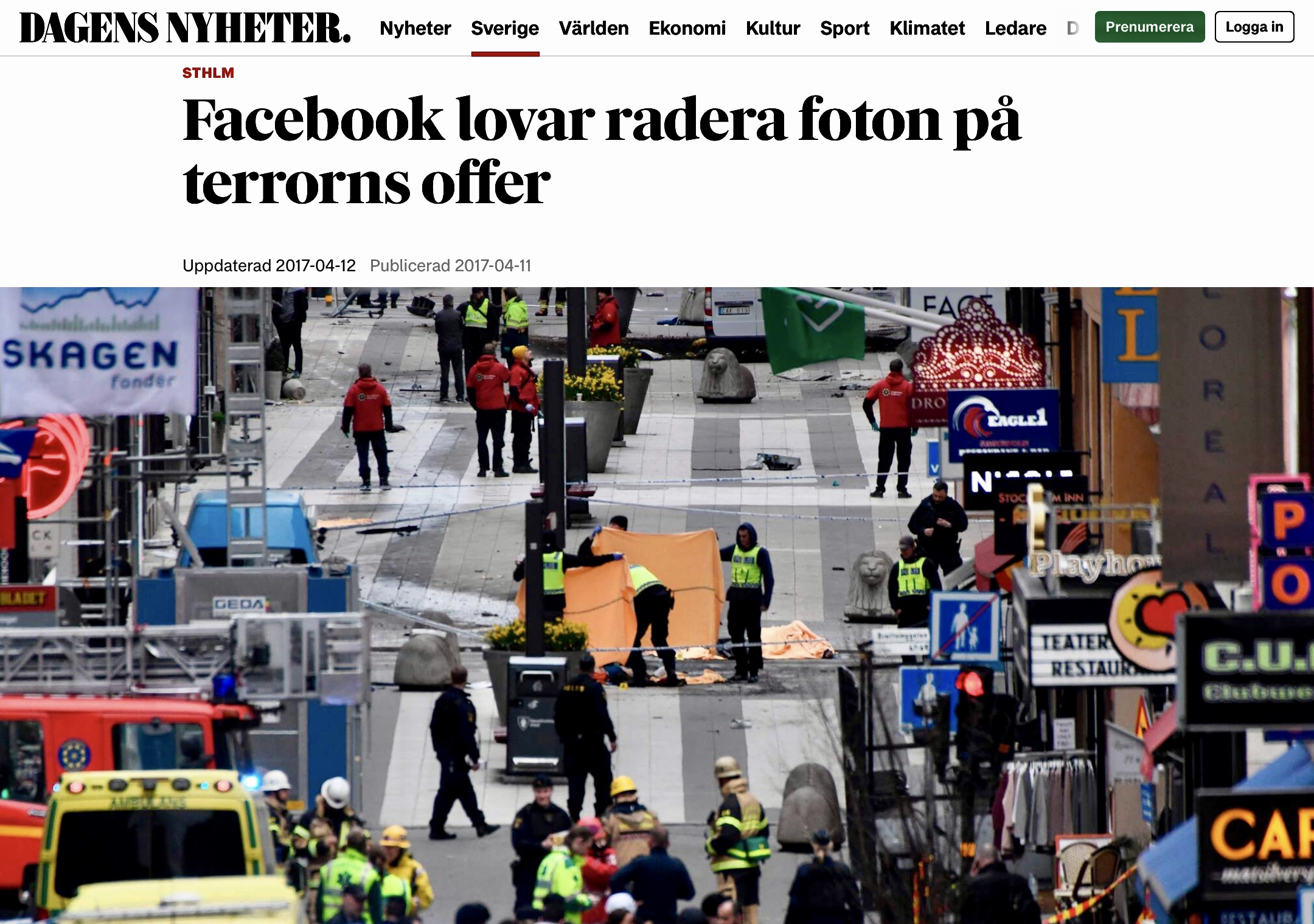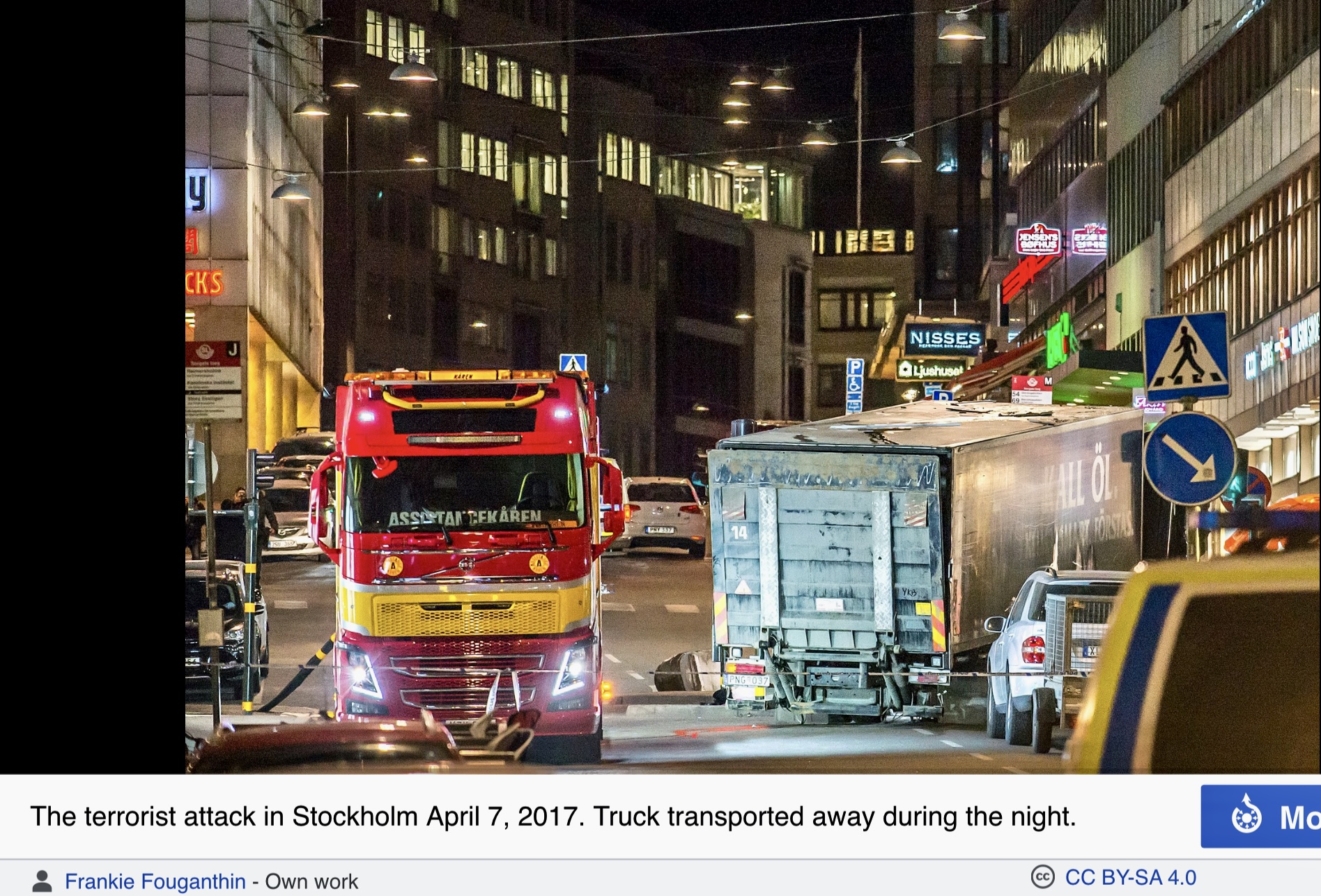Crowd-Engagement During Terror-Attack: Difference between revisions
Dinu (talk | contribs) No edit summary |
Dinu (talk | contribs) No edit summary |
||
| (3 intermediate revisions by 2 users not shown) | |||
| Line 2: | Line 2: | ||
|Use Cases Category=Real-world | |Use Cases Category=Real-world | ||
|Year=2017 | |Year=2017 | ||
|Publishing Organisation=Deutsche Hochschule der Polizei (DHPol) | |||
|Location=Stockholm, Sweden | |Location=Stockholm, Sweden | ||
|Event type=Terror | |Event type=Terror | ||
| Line 15: | Line 16: | ||
In response to the attack, the Stockholm authorities had put the city center in lockdown immediately: the Parliament House and the metro system were shut down. Stockholm Central Station was evacuated and all trains to and from Stockholm were put on hold until the evening hours. | In response to the attack, the Stockholm authorities had put the city center in lockdown immediately: the Parliament House and the metro system were shut down. Stockholm Central Station was evacuated and all trains to and from Stockholm were put on hold until the evening hours. | ||
|SMCS usage problems solving= | |Involved Organisations=volunteers | ||
|SMCS usage problems solving=The main objective of this use case was to identify the advantages and disadvantages of using social media and crowdsourcing during disaster events. | |||
|Use cases thematic=Making Information Accessible, Mobilising Citizens, Mobilising Volunteers | |Use cases thematic=Making Information Accessible, Mobilising Citizens, Mobilising Volunteers | ||
|Limitations=On social media, information and images of the attack immediately | |Limitations=On social media, information and images of the attack immediately spread, were shared and commented on by authorities, journalists and citizens, and set in motion a series of positive as well as negative developments: | ||
On the negative side, | On the negative side, much of the footage was freely available to anyone. Facebook was criticised for not deleting images of seriously injured or dead victims. It was only on 11 April that a spokesperson for the company said that the website had now started deleting these images. Also, circulating images of the massive security operation launched by the police contributed to the spread of rumors about alleged shootings. For example, a Swedish public television station reported live at around 3.00 p.m. that it had received witness statements about shots being fired near the scene. Such news of an ongoing attack led to increasing public uncertainty. In addition, the Swedish far-right contributed to further rumours on social media and deliberately produced "fake news" to profit from the incident. | ||
Several influential junctions emerged in the support network (see graphic above). However, the main actors who created and promoted the crowd-enabled actions were local people and not the authorities in charge of crisis management. | |||
Although some Swedish officials also engaged with the hashtag later in the evening, they remained a relatively passive part and made no real attempts to take the lead in this discourse and strategically steer it in a direction that would facilitate police work. Thus, the potential arising from such massive mobilization was not used. | |||
Moreover | Moreover - after the perpetrator was captured, the lockdown was over, and citizens had recovered from the initial shock - the dynamics surrounding #openstockholm changed drastically. Against the backdrop of evolving political debates on immigration laws and increased state measures to track down illegal immigrants in Sweden, the hashtag was hijacked by accounts propagating Islamophobia and anti-immigrant views. Thus, the Stockholm case also demonstrates how quickly extremely functional crowd dynamics can turn dysfunctional, and how easy it is to transform collective expressions of togetherness, efficient action, and pride into collective hatred, since social media plays a central role in public sense-making and coping after a massive disaster like a terrorist attack. | ||
|Worked well=On social media, | |Worked well=On a positive note, Stockholmers have used social media, especially Twitter, not only to provide massive support to those affected, but also to coordinate various efforts: In a tweet posted at 4:44 p.m., Jenny Nguyen, a Swedish law student, asked “Could we collect all who are opening their doors in Stockholm under one hashtag ‘#openstockholm’?”. | ||
Thus, like the hashtags that were suggested to enable support during other attacks (#PorteOuverte in Paris 2015, #openhouse in Brussels 2016; #opendoors in Nice 2016, #offenetür in Munich 2016, #roomformanchester in Manchester 2017 or #bedinbarcelona in Barcelona 2017), #openstockholm quickly attracted massive engagement and initiated a mobilization that thousands joined: By the end of the day of the attack, tweets with #openstockholm had been sent or retweeted over 21,000 times – a number which rose to 47,000 during the first five days after the incident. | |||
Initially, the hashtag was used to highlight safe locations and emergency shelters, but it was gradually expanded to share information about carpooling (by people posting their routes, times and destinations of transport), childcare and safety, food availability, shareable or open Wi-Fi connections to relieve congested mobile networks, etc. Several users also used the hashtag to update the state of knowledge about the event (e.g. the number of victims), to reflect official information from the authorities, or to call for not posting graphic images of victims or deliberately spreading rumours. Quantitative analyses of the tweets also revealed that the majority of posts were classified as rational reactions (such as concrete offers of help or information updates), but about one fifth of #openstockholm posts were symbolic reactions to the events, primarily expressions of appreciation for the helpers and (national) pride (e.g., “Proud of you who are opening homes.”, “So proud of this country.”). | |||
|Additional links=https://en.wikipedia.org/wiki/2017_Stockholm_truck_attack, | |||
'''Crisis Communication:''', | |||
[https://links.communitycenter.eu/index.php/ATTACKS_in_public_places Attacks in public places] | |||
|Other images=terror_stockholm_1.jpeg, terror_stockholm_2.jpeg | |||
}} | }} | ||
Latest revision as of 15:44, 29 November 2023
Last edited: 29 November 2023
Hazard:
TerrorYear:
2017Location:
Stockholm, SwedenScale:
CityInvolved Organisations:
volunteersPublishing Organisation
Deutsche Hochschule der Polizei (DHPol)
Category
Real-world
Theme
Crowdsourcing, Social Media
Thematic
- Making Information Accessible
- Mobilising Citizens
- Mobilising Volunteers
Disaster Management Phase
After, During
Description
On 7 April 2017, at about 14:53 local time, a hijacked truck was deliberately driven into crowds along Drottninggatan in central Stockholm before being crashed into a department store. Five people were killed, 14 others were seriously injured. This was considered to be the first major terrorist attack of its kind in Sweden. The perpetrator, a 39-year-old rejected asylum seeker from Uzbekistan with alleged affiliations to the Islamic State, was apprehended several hours later. In 2018 he was convicted of murder and terrorist crimes and was sentenced to life in prison and deportation to Uzbekistan, if released.
In response to the attack, the Stockholm authorities had put the city center in lockdown immediately: the Parliament House and the metro system were shut down. Stockholm Central Station was evacuated and all trains to and from Stockholm were put on hold until the evening hours.What was the overall goal of the Use Case?
The main objective of this use case was to identify the advantages and disadvantages of using social media and crowdsourcing during disaster events.What worked well and could be recommended to others?
On a positive note, Stockholmers have used social media, especially Twitter, not only to provide massive support to those affected, but also to coordinate various efforts: In a tweet posted at 4:44 p.m., Jenny Nguyen, a Swedish law student, asked “Could we collect all who are opening their doors in Stockholm under one hashtag ‘#openstockholm’?”.
Thus, like the hashtags that were suggested to enable support during other attacks (#PorteOuverte in Paris 2015, #openhouse in Brussels 2016; #opendoors in Nice 2016, #offenetür in Munich 2016, #roomformanchester in Manchester 2017 or #bedinbarcelona in Barcelona 2017), #openstockholm quickly attracted massive engagement and initiated a mobilization that thousands joined: By the end of the day of the attack, tweets with #openstockholm had been sent or retweeted over 21,000 times – a number which rose to 47,000 during the first five days after the incident.
Initially, the hashtag was used to highlight safe locations and emergency shelters, but it was gradually expanded to share information about carpooling (by people posting their routes, times and destinations of transport), childcare and safety, food availability, shareable or open Wi-Fi connections to relieve congested mobile networks, etc. Several users also used the hashtag to update the state of knowledge about the event (e.g. the number of victims), to reflect official information from the authorities, or to call for not posting graphic images of victims or deliberately spreading rumours. Quantitative analyses of the tweets also revealed that the majority of posts were classified as rational reactions (such as concrete offers of help or information updates), but about one fifth of #openstockholm posts were symbolic reactions to the events, primarily expressions of appreciation for the helpers and (national) pride (e.g., “Proud of you who are opening homes.”, “So proud of this country.”).What limitations were identified?
On social media, information and images of the attack immediately spread, were shared and commented on by authorities, journalists and citizens, and set in motion a series of positive as well as negative developments:
On the negative side, much of the footage was freely available to anyone. Facebook was criticised for not deleting images of seriously injured or dead victims. It was only on 11 April that a spokesperson for the company said that the website had now started deleting these images. Also, circulating images of the massive security operation launched by the police contributed to the spread of rumors about alleged shootings. For example, a Swedish public television station reported live at around 3.00 p.m. that it had received witness statements about shots being fired near the scene. Such news of an ongoing attack led to increasing public uncertainty. In addition, the Swedish far-right contributed to further rumours on social media and deliberately produced "fake news" to profit from the incident.
Several influential junctions emerged in the support network (see graphic above). However, the main actors who created and promoted the crowd-enabled actions were local people and not the authorities in charge of crisis management. Although some Swedish officials also engaged with the hashtag later in the evening, they remained a relatively passive part and made no real attempts to take the lead in this discourse and strategically steer it in a direction that would facilitate police work. Thus, the potential arising from such massive mobilization was not used.
Moreover - after the perpetrator was captured, the lockdown was over, and citizens had recovered from the initial shock - the dynamics surrounding #openstockholm changed drastically. Against the backdrop of evolving political debates on immigration laws and increased state measures to track down illegal immigrants in Sweden, the hashtag was hijacked by accounts propagating Islamophobia and anti-immigrant views. Thus, the Stockholm case also demonstrates how quickly extremely functional crowd dynamics can turn dysfunctional, and how easy it is to transform collective expressions of togetherness, efficient action, and pride into collective hatred, since social media plays a central role in public sense-making and coping after a massive disaster like a terrorist attack.Which hashtags or keywords were used?
#openstockholmAdditional Links
- https://en.wikipedia.org/wiki/2017_Stockholm_truck_attack
- Crisis Communication:
- Attacks in public places


